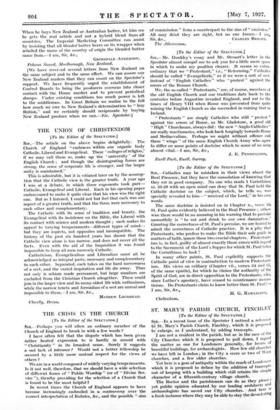THE UNION OF CHRISTENDOM
[To the Editor of the SPECTATOR.] Sias—The article on the above begins, delightfully. The Church of England "embraces within one organic body Catholic, Liberal and Evangelical. These ' colleges of religion,' if we may call them so, make up the ' university ' of the English Church ; and though the disintegrating forces are strong, the sense of corporate life is stronger, and the larger unity is maintained."
This is admirable, but it is vitiated later on by the assump- tion that the Catholic view is the greater truth. A year ago I was at a debate, in which three exponents took part— Catholic, Evangelical and Liberal. Each in his opening paper endeavoured to make it quite clear that his view was the right one. But as I listened, I could not but feel that each was one aspect of a greater truth, and that the three were necessary to each other and complementary.
The Catholic with its sense of tradition and beauty, the Evangelical with its insistence on the Bible, the Liberal with its contact with science and modern thought ; each makes its appeal to varying temperaments—different types of mind— but they are aspects, not opposites and incompatible. The history of the past six hundred years has shown that the Catholic view alone is too narrow, and does not cover all the facts. Even with the aid of the Inquisition it was found impossible to keep all men narrowly Catholic.
Catholicism, Evangelicalism and Liberalism must all be acknowledged as integral parts, necessary and complementary to each other. Separated, each takes on the hard narrowness of a sect, and the varied inspiration and life die away. Thus not only is schism made permanent, but large numbers are excluded from the Christian Church altogether. These could join in the larger view and its many-sided life with enthusiasm, while the narrow tenets and formalism of a sect are unreal and impossible to them.—I am, Sir, &c.,














































 Previous page
Previous page